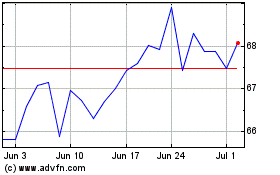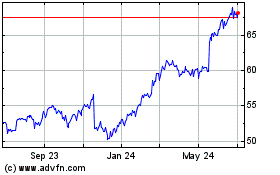Wal-Mart Cheers Investors With Revenue Growth, Upbeat Outlook--Update
May 19 2016 - 8:50AM
Dow Jones News
By Joshua Jamerson
Wal-Mart Stores Inc. on Thursday posted surprise revenue growth
in the first quarter and offered an upbeat view for the second,
bolstered by strength in its health and wellness segment.
Shares of Wal-Mart jumped 8.1% to $68.25 in premarket trading,
as results were in contrast with several retailers that have
reported weaker results recently.
Wal-Mart said its sales were helped by strength in U.S. segments
such as health and wellness, apparel, and home and seasonal. More
scripts at its pharmacies, along with branded drug inflation, led
to mid-single digit comparable sales growth in the health and
wellness unit.
More than half of Wal-Mart's sales come from its grocery
business, which led analysts to believe the company could be
insulated from the difficult apparel environment. But its grocery
operations are also vulnerable to food deflation and pricing
competition; grocery sales declined by low single-digits during the
first quarter, as strong traffic in grocery was offset by
deflation.
Wal-Mart said its general merchandise sales rose by low-single
digits thanks to a "focus on basics."
The Bentonville, Ark., company has been spending heavily to get
customers back into its stores. It has worked to better stock
stores, improve efficiency and increase pay for its employees. But
Wal-Mart has warned that those efforts would dent profits this
fiscal year.
Indeed, profit slipped 7.8% in the first quarter, but it still
topped the company's expectations.
Wal-Mart's results stand out from a list of retailers with
disappointing starts to the year. On Wednesday, Target Corp.
reported that consumers pulled back on spending, with its chief
executive citing "an increasingly volatile consumer environment."
Soft results from department stores like Macy's Inc. and Nordstrom
Inc. illustrated shoppers' shift away from brick-and-mortar stores
and sparked declines across the retail sector.
Retailers have been closing weaker locations and investing in
e-commerce as consumers shift online shopping and fast-fashion
chains. But the moves haven't been enough to counter weak
demand.
Wal-Mart's operating, selling, general and administrative
expenses climbed 6.3% to $24.09 billion in the quarter, in part due
to efforts to beef up its online business.
"We are focused on building the e-commerce capabilities we need
to drive growth to a higher level and deliver the seamless shopping
experience for customers they desire," said Doug McMillon,
Wal-Mart's chief executive.
Off-price chain TJX Cos. and home-improvement stores like Home
Depot Inc. have reported healthy traffic and spending at their
locations, suggesting that consumers are willing to spend but are
being more selective about where.
In the first quarter, sales at Wal-Mart's existing U.S. stores
ticked up 1%, marking the seventh straight quarterly gain after a
long stretch of declines. Analysts polled by Consensus Metrix
expected 0.5% growth in the metric.
The number of people visiting Wal-Mart's stores rose 1.5%.
Over all, Wal-Mart reported a first-quarter profit of $3.08
billion, or 98 cents a share, down from $3.34 billion, or $1.03 a
share, a year earlier. Wal-Mart had forecast earnings of 80 cents
to 95 cents a share. Analysts anticipated 88 cents.
Revenue rose 0.9% to $115.9 billion, above the $113.2 billion
analysts polled by Thomson Reuters had forecast. Excluding currency
impacts, revenue rose 4%.
For the second quarter, the company said it expects earnings
between 95 cents and $1.08 a share. Analysts were expecting
second-quarter profit of 98 cents.
Write to Joshua Jamerson at joshua.jamerson@wsj.com
(END) Dow Jones Newswires
May 19, 2016 08:35 ET (12:35 GMT)
Copyright (c) 2016 Dow Jones & Company, Inc.
Walmart (NYSE:WMT)
Historical Stock Chart
From Mar 2024 to Apr 2024

Walmart (NYSE:WMT)
Historical Stock Chart
From Apr 2023 to Apr 2024
